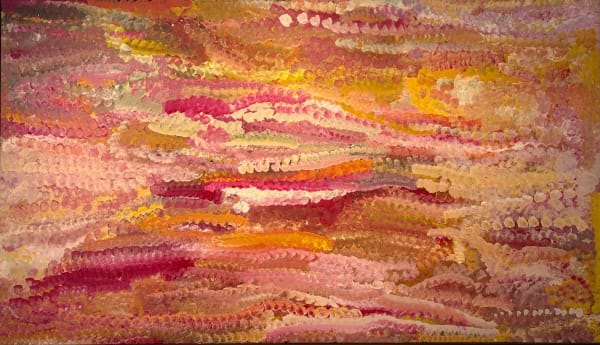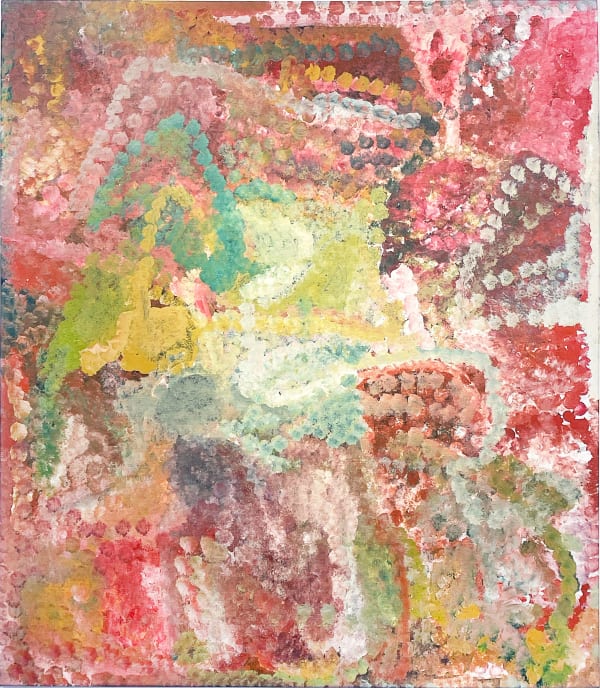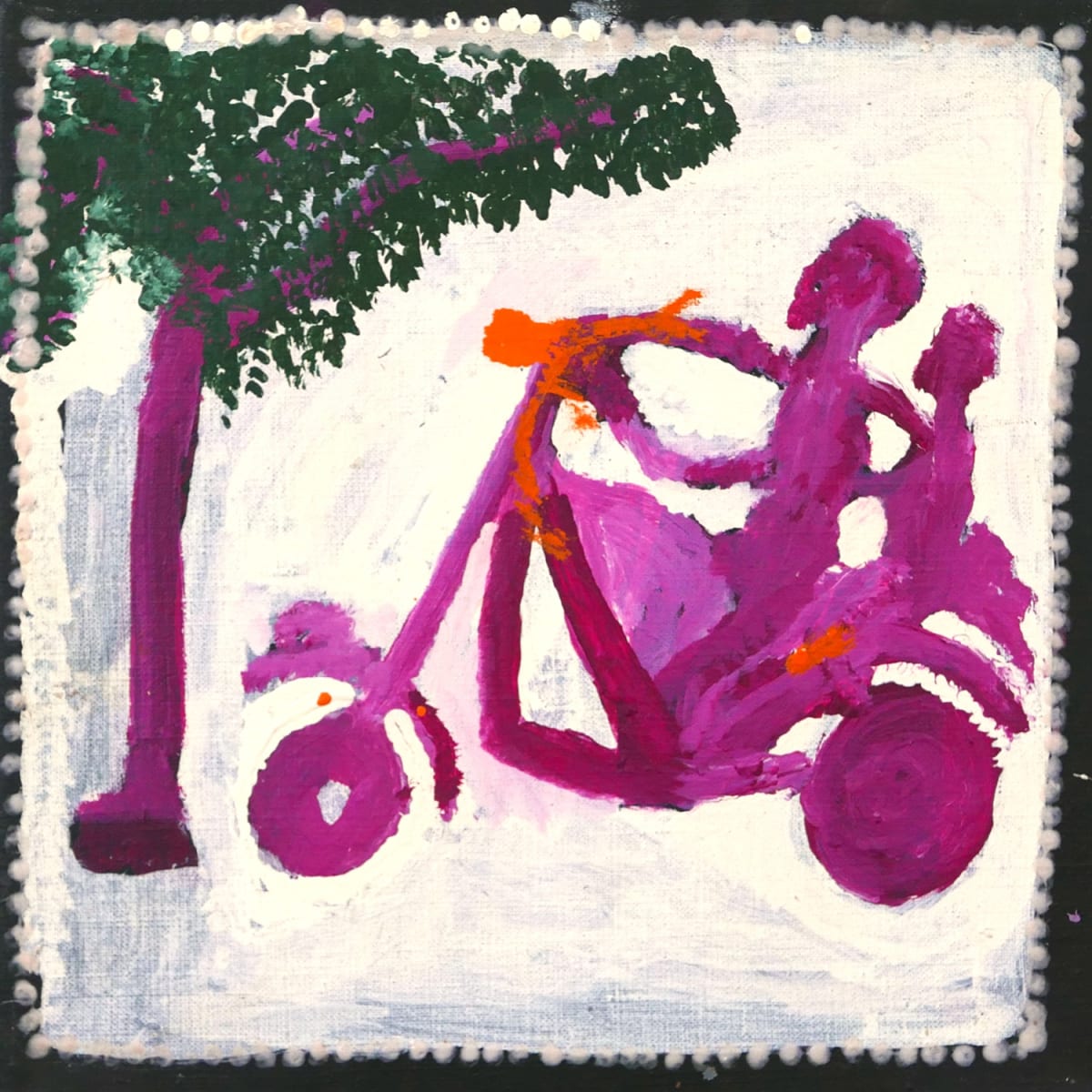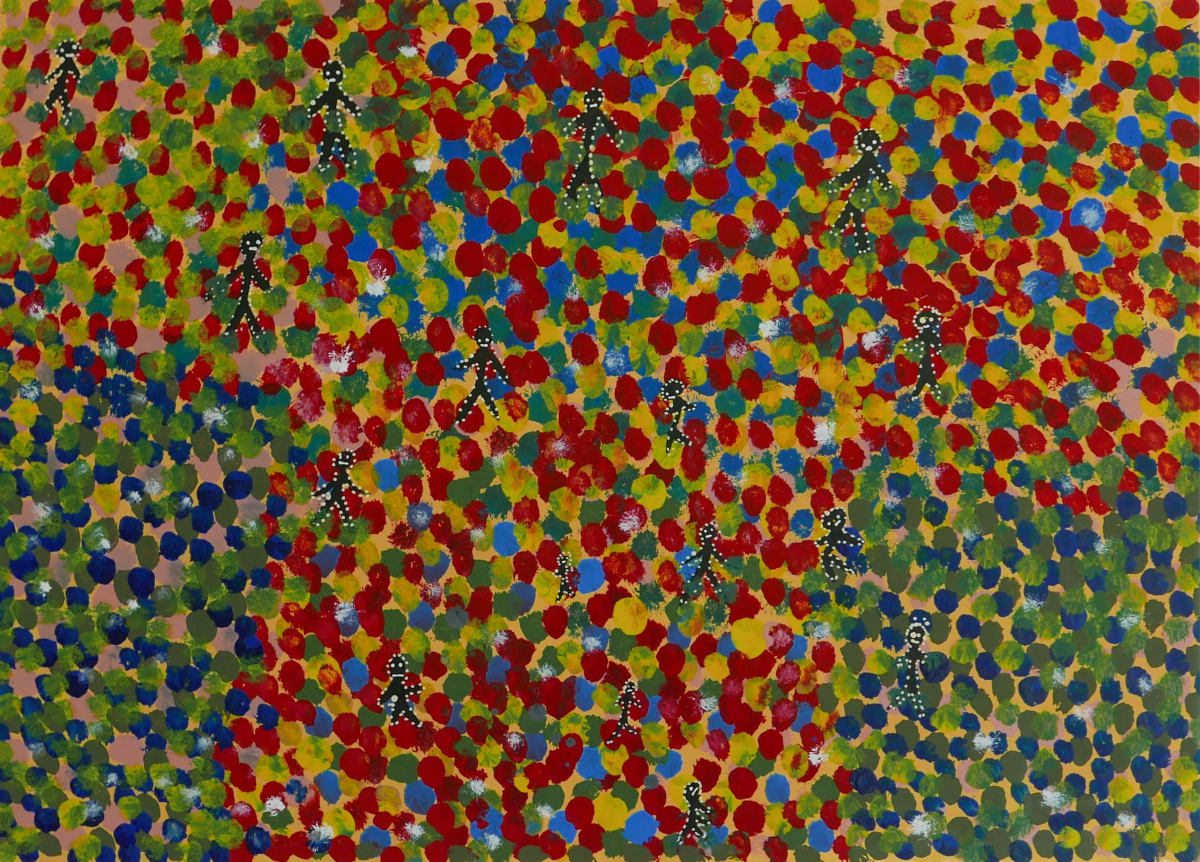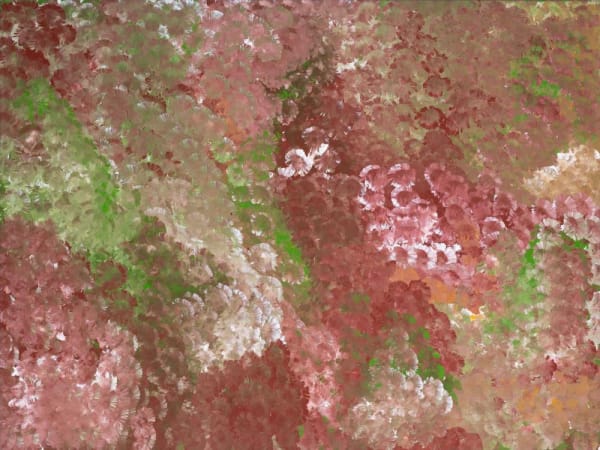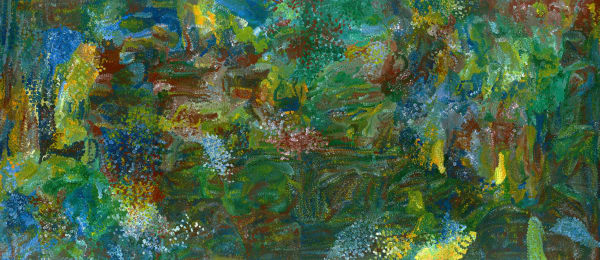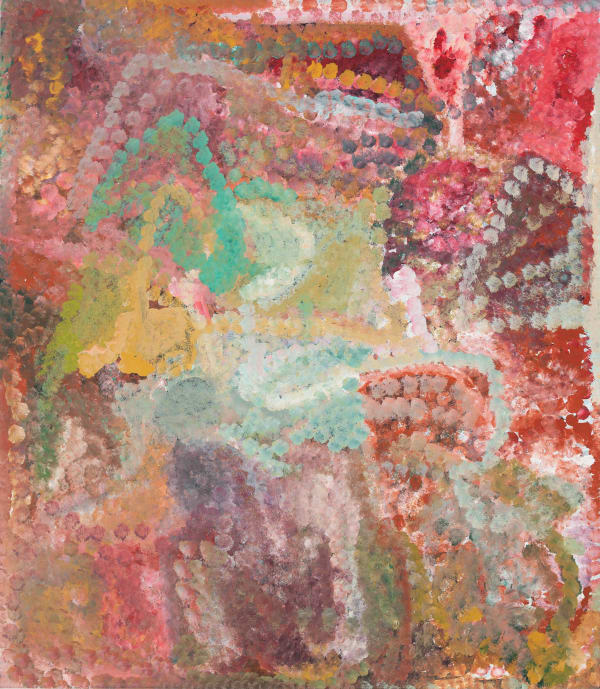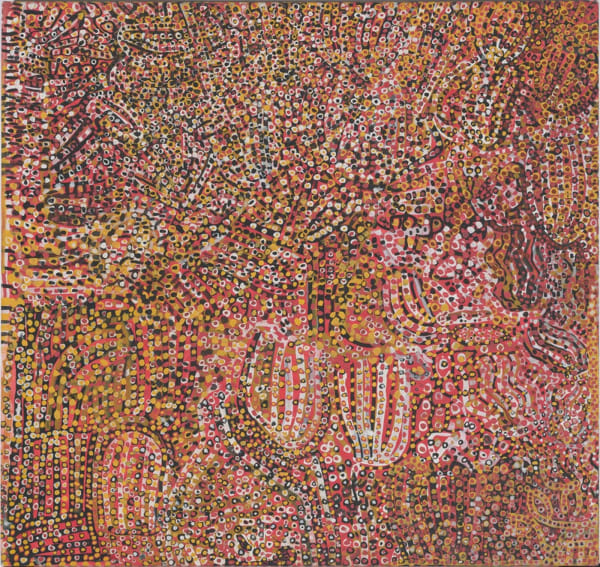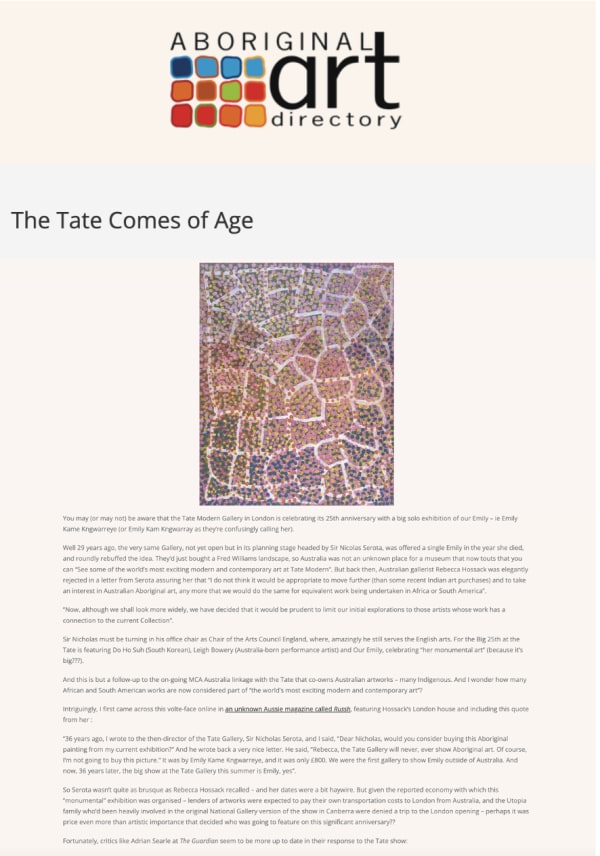Emily Kam Kngwarray
Overview
One of the most important Aboriginal painters of the twentieth century, Emily Kam Kngwarray (b. 1910 - 1996) began painting in earnest in her early seventies. Emily Kam Kngwarray’s oeuvre was inspired by her role as an Anmatyerre elder and her custodianship of the women’s Dreaming sites in her clan Country, Alhalkere. Millenia-old women’s lore is preserved and inherited through both storytelling and visual traditions, including designs painted on human bodies, traced in the earth, or carved into the landscape.
Despite finding her spirited vocation in the final years of her life, Emily Kam Kngwarray’s works on canvas sparkle with the broad mythopoetry of the landscape and a full knowledge of her country: its ritual ceremonies, cultivation and harvest, spiritual forces and ancient lore. As a custodian of her sacred country, Emily Kam Kngwarray’s painting captures both minutia and vastness: from grains of sand and seed pods to the vastness of the sky and terrain. Her middle name, Kam, denotes the sustaining pencil yam and its seeds—Emily’s totem, and the motivating force of her oeuvre.
The artist referred to this simultaneous evocation as the 'whole lot'. Emily Kam Kngwarray’s ability to capture such depth of meaning came from her traditional upbringing, largely untouched by Western influence until the late stages of her life. Emily Kam Kngwarray’s painting developed through the ceremonial communication of the Dreaming. Her style is drawn from the body painting iconography of the Anmatyerre women’s ceremony called Awelye. During Awelye, Anmatyerre women painted Dreaming designs on their chests and shoulders using pigments ground from the earth - a fusion of earth and body. As they paint these designs, they chant their Dreaming, which can last for many hours, culminating in a final dance and chant. During the late 1970s, Anmatyerre women performed Awelye to demonstrate their ownership of territories, stories and Dreamings, which played a critical role in reclaiming their rights to the land. Following the passing of the Aboriginal Land Rights Act 1976, Emily Kam Kngwarray and her naitive Anmatyerre community returned to their ancestral homelands and continued to live according to the laws and customs of the clan. In 1977, Emily Kam Kngwarray and other artists formed the Utopia Women’s Batik Group, whose members developed techniques to reimagine Awelye body painting into batik decoration on silk. Emily Kam Kngwarray continued to paint Awelye designs after she and the other Utopian artists started using acrylic paint on canvas in the late 1980s, whilst developing a painterly ‘allover style’ of gestural swipes and clotted dotting.
Emily Kam Kngwarray is unique among Indigenous Australian painters for her prolific and innovative style, matched with a revered and distinctive color-sense. Working on intimate and monumental scales alike, the artist employed brushes, sticks, and fingertips on unstretched linen laid flat on the ground, sitting beside or within the composition itself. Emily Kam Kngwarray has been the subject of several museum surveys in Australia and Japan, and her work featured prominently in the 56th Biennale di Venezia in 2015.
Her work is also the subject of a major one-person exhibition at Tate Modern in July 2025, curated in collaboration with the National Gallery of Australia.
Works
Exhibitions
-

Motorbike Paddy, Emily Kam Kngwarray and the Wonders of Utopia
9 July - 30 August 2025For thirty-seven years, the Rebecca Hossack Art Gallery has been a leading champion of Aboriginal art in the UK. In 1996, the gallery gave Emily Kam Kngwarray her first solo exhibition outside Australia — at a time when few in the British art establishment recognised the significance of Aboriginal art....Read more -

Family: Artists From Utopia
8 July - 31 August 2024 LondonThe Rebecca Hossack Art Gallery presents Family: Artists from Utopia. In advance of the forthcoming retrospective of the pioneering Aboriginal artist, Emily Kam Kngwarrey, this historic survey exhibition brings together a collection of previously unseen works produced over the past three decades by artists from the remote Central Desert community...Read more
Press
-

Emily Kngwarray: a tribute by Rebecca Hossack
Independent -

Utopian ideals: Two exhibitions pay tribute to Aboriginal Artist Emily Kam Kngwarray
Phil Brown, Art Beat -

Late desert flowers: Emily Kam Kngwarray
Giles Auty, The Weekend Australian, March 1998 -

Art for art's sake: Emily Kngwarray
The Sydney Morning Herald -

Too many dots: Emily Kngwarray
Susan McCulloch, The Weekend Review, September 1996 -

Curator Enoch Cheng on Creating Connections and the Evolution of the Hong Kong Annual Art Fair
Robb Report Hong Kong -

Fame Finds Emily at borehole: Emily Kam Kngwarray
Tony Stephens, The Sydney Morning Herald, 23 April 1990 -

Kngwarray colours the world
Daphne Guinness, The Australian, 11 December 1992 -

Emily Kngwarray and Axel Poignant Exhibition at Rebecca Hossack
Time Out, 29 September 1993 -

UK finds Utopia: Emily Kam Kngwarray
Alex Mitchell, The Sydney Sun Herald, 5 June 1994 -

Emily's gift: The late flowering of a desert genius
Jane Cadzow, The Sydney Morning Herald Magazine, 5 August 1995 -

Emily Kngwarray Obituary
Rebecca Hossack, Independent, 6 September 1996 -

Emily Kam Kngwarray: 'That's what I paint: a whole lot'
Janine Burke, The Age, 13 June 1998 -

The Top 5 Art Exhibitions to see in London in August
Motorbike Paddy, Emily Kam Kngwarray and other utopias at Rebecca Hossack GalleryTabish Khan, 1 August 2025 -

The Tate Comes of Age
Aboriginal Art Directory8 September 2025
Related Content

